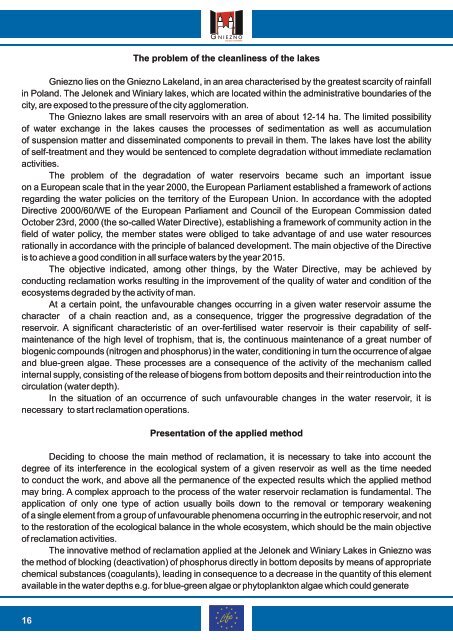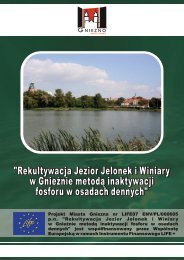Broszura duża - Gniezno, Urząd Miasta
Broszura duża - Gniezno, Urząd Miasta
Broszura duża - Gniezno, Urząd Miasta
- No tags were found...
You also want an ePaper? Increase the reach of your titles
YUMPU automatically turns print PDFs into web optimized ePapers that Google loves.
The problem of the cleanliness of the lakes<strong>Gniezno</strong> lies on the <strong>Gniezno</strong> Lakeland, in an area characterised by the greatest scarcity of rainfallin Poland. The Jelonek and Winiary lakes, which are located within the administrative boundaries of thecity, are exposed to the pressure of the city agglomeration.The <strong>Gniezno</strong> lakes are small reservoirs with an area of about 12-14 ha. The limited possibilityof water exchange in the lakes causes the processes of sedimentation as well as accumulationof suspension matter and disseminated components to prevail in them. The lakes have lost the abilityof self-treatment and they would be sentenced to complete degradation without immediate reclamationactivities.The problem of the degradation of water reservoirs became such an important issueon a European scale that in the year 2000, the European Parliament established a framework of actionsregarding the water policies on the territory of the European Union. In accordance with the adoptedDirective 2000/60/WE of the European Parliament and Council of the European Commission datedOctober 23rd, 2000 (the so-called Water Directive), establishing a framework of community action in thefield of water policy, the member states were obliged to take advantage of and use water resourcesrationally in accordance with the principle of balanced development. The main objective of the Directiveis to achieve a good condition in all surface waters by the year 2015.The objective indicated, among other things, by the Water Directive, may be achieved byconducting reclamation works resulting in the improvement of the quality of water and condition of theecosystems degraded by the activity of man.At a certain point, the unfavourable changes occurring in a given water reservoir assume thecharacter of a chain reaction and, as a consequence, trigger the progressive degradation of thereservoir. A significant characteristic of an over-fertilised water reservoir is their capability of selfmaintenanceof the high level of trophism, that is, the continuous maintenance of a great number ofbiogenic compounds (nitrogen and phosphorus) in the water, conditioning in turn the occurrence of algaeand blue-green algae. These processes are a consequence of the activity of the mechanism calledinternal supply, consisting of the release of biogens from bottom deposits and their reintroduction into thecirculation (water depth).In the situation of an occurrence of such unfavourable changes in the water reservoir, it isnecessary to start reclamation operations.Presentation of the applied methodDeciding to choose the main method of reclamation, it is necessary to take into account thedegree of its interference in the ecological system of a given reservoir as well as the time neededto conduct the work, and above all the permanence of the expected results which the applied methodmay bring. A complex approach to the process of the water reservoir reclamation is fundamental. Theapplication of only one type of action usually boils down to the removal or temporary weakeningof a single element from a group of unfavourable phenomena occurring in the eutrophic reservoir, and notto the restoration of the ecological balance in the whole ecosystem, which should be the main objectiveof reclamation activities.The innovative method of reclamation applied at the Jelonek and Winiary Lakes in <strong>Gniezno</strong> wasthe method of blocking (deactivation) of phosphorus directly in bottom deposits by means of appropriatechemical substances (coagulants), leading in consequence to a decrease in the quantity of this elementavailable in the water depths e.g. for blue-green algae or phytoplankton algae which could generate16



